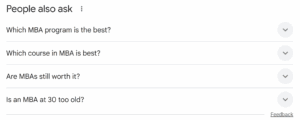If you’re not targeting these keywords, you’re missing prospective students
Search behavior is evolving fast, and higher ed marketing teams need to adapt to stay visible. If you haven’t already, it’s time to rethink your keyword search strategy to keep pace. In part two of our series on on-page SEO for higher ed, I’ll break down what long-tail keywords are, why they matter, and how to use them—plus how AI can help you boost visibility in both traditional and AI search.
Read Blog #1 in Our Series: Balance Branded and Non-Branded Keywords in Your Strategy
What are short-tail and long-tail keywords?
“Long-tail” keywords are specific, multi-word phrases that attract niche audiences with clear intent. “Short-tail” keywords, on the other hand, are broader—usually one or two-words—and tend to generate high search volume. While short-tail keywords may seem more desirable because of the volume, long-tail keywords are often more valuable for attracting qualified, high-intent prospects.
Think of short-tail keywords as the “head” of a query. A term like “MBA” gets a lot of searches, but the searcher’s intent is often vague. Are they curious about what an MBA is? Are they already enrolled? Just comparing options? These terms are also highly competitive. The screenshot below reflects monthly search volume for a few MBA-related terms. The higher the keyword difficult percentage (KD%), the harder it is to rank.

Long-tail keywords are typically three or more words and more conversational. They reflect how prospective students actually talk and search—whether in a search engine, on an AI platform, or using voice search.
Let’s go back to our MBA example. Instead of just “MBA,” long-tail keywords might be:
- “part-time online MBA programs for working professionals”
- “best MBA programs with a concentration in sustainable business”
- “is an mba higher than a masters”
- “cost of an executive MBA program in Atlanta”
- “how to choose an MBA program for career changes”
These lower-volume, non-branded phrases—keywords that don’t mention your institution by name—are far more likely to attract prospective students who are actively exploring their options and haven’t yet discovered your university.
Learn the New Rules of AI-Ready Keyword Optimizations
Why long-tail keywords matter for colleges and universities
For higher education institutions, optimizing your search strategy for long-tail keywords offers several key benefits:
- Higher intent, better leads: As shown in the MBA example, long-tail keywords indicate stronger student intent. A prospective student searching for “online MBA programs for working professionals” is further along in their journey than someone searching for “MBA.”
- Less competition, easier ranking: Broad keywords are often dominated by top-ranking sites like Wikipedia and U.S. News & World Report. Long-tail keywords are less competitive, making it easier for your university’s program pages and content to rank in search results.
- Align with evolving search behavior: With the rise of AI and voice search, people are searching using longer, more conversational phrases. Optimizing your strategy for long-tail keywords means your content matches how users are searching today.
- Build authority and trust: When your content answers detailed, specific queries, your institution earns credibility and trust—core principles of Google’s E-E-A-T (Experience, Expertise, Authoritativeness, Trustworthiness) guidelines for online content. This helps keep your content visible across all types of search.
How to find long-tail keywords: Traditional and AI-powered approaches
So, how do you find the right long-tail keywords for your MBA program, or any other offering?
- Google autocomplete and related searches: Type a general term (e.g., “MBA program”) into Google. The autocomplete suggestions reflect real searches people are conducting. Scroll to the bottom of the results page to see more ideas in the “related searches” section.

- People Also Ask (PAA): Google often displays a “People Also Ask” box with common questions tied to your search. These are natural sources of long-tail keyword inspiration.

- Q&A platforms (Reddit, Quora): These forums are full of real prospective students asking real questions. Try searching broad terms such as “MBA programs” to uncover user-generated long-tail keywords such as “MBA application tips” or “is an online MBA worth it?”
- Your own website analytics: Google Search Console (GSC) can show you the exact phrases people use to find your site. Under the “Performance” report, check the “Queries” section: you’ll likely find long-tail keywords you weren’t even targeting.
- AI powered keyword research: Tools like ChatGPT and Gemini can generate keyword ideas quickly. They’re especially useful for brainstorming questions, comparisons, and niche content ideas. Always vet the outputs to ensure they’re relevant to your programs. Try prompts like:
- “Generate long-tail keywords for an online MBA program.”
- “What questions do prospective students ask about MBA scholarships?”
- “Give me long-tail keyword ideas for an executive MBA in healthcare management.”
- “Create a list of long-tail keywords related to MBA career outcomes.”
- Search visibility and audit tools: Some SEO tools now include AI features—some assess your brand’s presence across AI platforms, while others analyze search trends, competitor data, and user intent to surface relevant long-tail keywords. While these tools are powerful, they assume users know how to interpret the data and what to do with it. They can show keyword rankings and performance trends—but they don’t tell you which page to prioritize, how your content appears in AI search results, or which long-tail keywords could improve visibility with high-intent prospects.
EAB’s Search Visibility Audit goes beyond traditional SEO tools by showing how your content performs across AI search platforms like ChatGPT, Google AI Overview, and Perplexity. The audit highlights visibility gaps on your enrollment-critical pages, surfaces the long-tail keywords your prospects are using, and benchmarks your performance against key competitors. You’ll get clear, actionable insights tied to enrollment goals so you know exactly where to focus and what to fix.

Explore EAB’s Search Visibility Audit and AI-Forward Content Solutions
Embrace long-tail keywords
Once you’ve evaluated your visibility and keyword strategy, use those insights to guide your content. If your data shows high impressions for a query like “MBA versus MBA IT Management,” and you see similar phrasing in your research, consider writing a dedicated page or blog post titled, “An MS in IT Management versus an MBA,” and link it to your relevant program pages.
Search engines and AI platforms are built to answer questions. When your content reflects long-tail queries, your institution’s website is more likely to become that answer—earning visibility, authority, and trust.
Your next step
If your college’s visibility in the age of AI search feels uncertain, you’re not alone. Partnering with trusted experts to audit your content and build a strategy that drives both visibility and enrollment can help you make the most of your most powerful marketing tool: your .edu.

More Blogs

AI visibility is critical when competing for student enrollments

What changed in the graduate lead gen landscape in 2025
